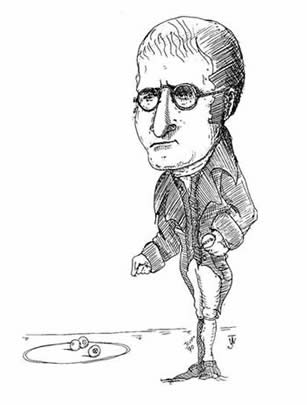
"Atomic Marbles "
April 9, 2007
John Dalton (1766-1844). A self-educated Quaker, Dalton was born in the village of Eaglesfield in northwest England and worked as a school teacher most of his life. Originally interested in meteorology, he kept detailed records of the local weather for many decades. His first book, Meteorological Observations and Essays (1793) dealt with the physics of mixed gases in the atmosphere and led to the discovery of his famous law of partial pressures, as well as to an interest in the chemical aspects of the atmosphere and ultimately to his chemical atomic theory. Whereas 17th-century corpuscularism had focused on atomic shape and the 18th-century dynamic atomism of Newton on interatomic forces as the keys to chemical behavior, Dalton focused instead on atomic weight. In 1805 he published his first table of atomic weights and in 1808 he summarized his new atomistic approach to chemistry in the first volume of his book, A New System of Chemical Philosophy. Unfortunately Dalton's procedures for extracting atomic weights from gravimetric composition, via his so-called rules of simplicity, were flawed and virtually all of his reported atomic weights are now known to be incorrect. The result was almost 50 years of confusion in which chemists used a variety of competing atomic and equivalent weight scales. Not until the publication of Cannizzaro's work in 1858 was this problem finally resolved. Dalton is also known for having given the first accurate description of color blindness (1794), which is often called Daltonism in his honor.
Courtesy of Professor William Jensen, Oesper Chair of the History of Chemistry and Chemical Education, University of Cincinnati
> Past Notable Chemists